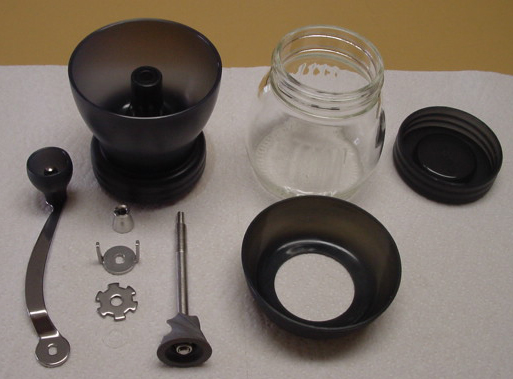PERSONAL EXERTION: THE SOLUTION
Having surveyed masses of online reviews and materials on this middle market of grinders, my final conclusion has been to purchase a hand grinder, the Hario Skerton Mill. Hand grinders give an individual more control and more accuracy than mid-range electric grinders and cost considerably less than an equivalently capable electric model (£35 for the Hario). For my own purposes, I am not grinding for espresso but for filter - either pour-over (guide here: http://prima-coffee.com/blog/v60-brewmethod-review) or aeropress (guide here: http://www.hasbean.co.uk/aeropress/AeropressGuidefinal.pdf). This is significant because most grinder obsessives are trying to attain a perfect level of consistency with incredibly fine espresso grounds, which need to allow water to pass through the densely packed basket of coffee and absorb natural oils in a short but powerful extraction process. Filter processes, like the pour-over and aeropress, in contrast use slightly coarser grinds, more like sand than the powder needed for espresso. The failure of internet brewing guides is that it is impossible to communicate ideal grind settings online because of the tiny incremental differences at stake. But even within the world of filter brewing the setting of the grind - also known as 'dialling in' - can vary between each brew method and even between approaches to single brewing processes. A french press requires just about the coarsest setting usable for extraction (save for perhaps a 24-hour cold-brew method: http://www.home-barista.com/tips/anybody-try-cold-brewed-coffee-t18239-20.html) whereas an aeropress grind is much finer. I mention these differences because as someone using filter extraction methods, I still need access to a variety of possible grind settings, which means I need my grinder to be able to deliver for a number of different purposes.

Hario, the Japanese company who produce my Skerton grinder, is acknowledged as a crucial manufacturer in the world of specialist coffee. Hario introduced a number of products which are now commonplace in many coffee shops and restaurants around London, especially the trio of V60 drippers, glass decanters and pouring kettles - all of which feature in my morning coffee set-up. Their Skerton hand grinder is a decent model, although it is disinterested in convenience or ease of use, instead creating a tacit contract of labour with its user that is not inconsiderable. To grind 15 grams of coffee requires 240 full revolutions of the grinder’s handle, approximately four minutes of continuous arm movement. The overall results, though, are excellent, with two well-designed conical ceramic burrs which when pushed against each other collide with an even and flush fit.
There is, however, an essential problem with the Skerton’s design with regards to how these burrs interact. The upper ceramic burr is fitted into the plastic upper chamber of the grinder, which screws into a lower glass chamber where the resulting grounds fall. The lower burr, however, is screwed through the middle of the upper chamber’s grinder mechanism with just a single plastic stabilizer in place. The lower burr is at the bottom of a long cylinder of metal which threads upwards through the plastic support, with a metal washer screwed at the top which both holds the burr in place and also can be adjusted to determine the coarseness of the grind. The further the distance is set between the two burrs, the more unstable the lower burr proves to be. There is a palpable wiggle of the lower burr when grinding on a coarser setting, which can only mean that at some points the coffee is being ground finely at one side of the burrs meeting point, whilst at the same time a wider gap exists on the opposite side. This is a surefire sign of an inconsistent grind but there are a number of possible solutions that have been feted online.
I end this text with three external links to online tutorials on how simple and cheap modifications can resolve the issue of burr engagement on the Hario Skerton hand grinder. With these simple material additions, this is a readily usable and cheap option for even grinds of coffee for multiple brew methods. As such, we arrive at the brewing process with one key element in place for experimenting with brew processes and extraction times. I should point out that before embarking too quickly ahead on the variables at stake with extraction processes, it is also worth thinking about the other core components necessary prior to brewing: the coffee’s genealogy (is it farmed with care and do local growing conditions make for good tasting coffee?), the roasting of the bean (the roast should amplify the natural flavours of the bean, rather than articulating the generic flavours available when cooking coffee seeds) and the quality of your brew water (a common problem if using London taps). With these elements in place and clean equipment at your disposal, the real job can begin by testing different brewing techniques, extraction times, filter materials, etc.
‘TOWARDS EVENNESS’, Page 3 of 4